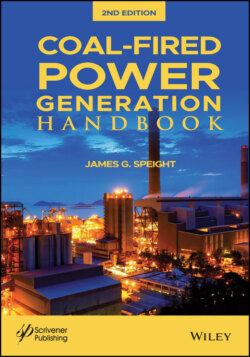Читать книгу Coal-Fired Power Generation Handbook - James Speight G., James G. Speight - Страница 108
4.6 Preventing Spontaneous Ignition
ОглавлениеPut simply, coal should be stored in specifically designed bunkers, silos, bins, or in outside piles (CFR, 2012). The most important aspects of coal storage are minimizing the flow of air through the pile, using the first-in, first-out rule of thumb, and minimizing the amount of finely divided coal in the pile. Hot spots should be removed or exposed to the atmosphere to allow cooling. Coal should be compacted if possible to reduce the amount of air in the pile. Water may be used to cool hot spots, but should be used with caution on large areas of hot coal to present accumulations of hazardous amounts of water. Coal should not be stored in outside piles located over utility lines, such as water lines and gas lines.
In order to prevent spontaneous ignition and combustion of coal, it is (first) necessary to understand coal properties and their influence on self-heating and ignition. Next (second), there is a group of additional factors that also play a major role in spontaneous ignition and combustion and these are (i) climatic conditions (temperature, relative humidity, barometric pressure and oxygen concentration), (ii) stockpile compaction, as related to height and method of stockpiling, and (iii) stockpile consolidation, which is influenced by height, the method of formation, and the equipment used for the stockpiling operation.
Spontaneous combustion resulting from spontaneous ignition can be detected fairly early in the development of the fire, i.e., before any obvious smoke and/or flame. Any of the following may assist in early detection, depending upon the particular circumstances. For example, the temperature difference – heat haze and steam/vapor plumes – may be observed on cold mornings and in times of high humidity. Efflorescence caused by the decomposition of pyrites and sublimation of sulfur is a strong indication of heating in pyritic (high-sulfur) coals. Also, hot spots may also be detected by infrared monitoring instruments or photography. Routine surveying of stockpiles using infrared scanning devices is an excellent precaution in situations where spontaneous combustion may be likely to occur.
Spontaneous ignition is a time-dependent phenomenon. Early attention to the potential sources of problems may prevent occurrences of heating progressing to full-scale spontaneous combustion. Examples of commonly used methods of dealing with spontaneous combustion in different circumstances are detailed: (i) tailings, which are the power plant rejects, (ii) dams should be capped with at least three feet of inert non-carbonaceous material, (iii) top soil should be added and the whole area vegetated, (iv) the coarse reject should be placed in layers and compacted using a roller, particularly on the edges of the dump, so that the infiltration of oxygen is minimal – the total layer thickness should be no greater than 15 feet and each layer should be covered by a 3-foot thick layer of inert (non-carbonaceous) material and the final landform should be such that erosion and runoff is minimized and new areas of discard coal are not exposed to the atmosphere, (v) spoil heaps in strip-mining should result in accumulations of coal material, particularly if pyritic, being buried under inert spoil – although difficult to achieve, the most reactive material should be enclosed within less reactive material but if this is not possible, rehabilitation of the spoil heaps should take place as soon as possible and a thick layer of softs should be used before topsoil is added, (vi) product stockpiles and coal inventory in the cut should not be left longer than the incipient heating period – there is considerable variation in the time taken for heating to occur, but most mines have an understanding, based on experience, of the time limits for the product, and (v) the shape and orientation of stockpiles and dumps is often a critical criterion and a site-specific consideration – when the technique is feasible, considerable benefit can be obtained by building dumps in relatively thin compacted layers and longer-term stockpiles can be further safeguarded by spraying the surfaces with a thin (bituminous) coating to exclude air.
In summary, stockpile management to mitigate spontaneous ignition and combustion can be achieved by actions such as (i) cooling by ventilation or by water spraying to avoid increase of coal stock temperature, (ii) storing the coal in smaller stockpile lots to enable better cooling to prevent heating up of the coal in the stockpile, (iii) reducing access to air, i.e., by storage in compressed piles (packing coal tightly and compacting) or storage in closely covered airtight enclosure, (iv) reducing the fine powder content in the coal, (v) limit the height of stockpile, (vi) avoid conical heaps, which tend to increase the surface area and, hence, the risk of fire, (vii) follow the practice of first-in, first-out in stockpile management – the old parts of the stockpile should be used first for consumption and the fresh coal should go for storage.
In summary, actions that could diminish the intensity of the self-ignition process and prevent production loss through fires are: (1) prevent access of fresh air by covering the stockpile with unreactive heavy oil, (2) storage of coal with small particle size, (3) storage of coal with low humidity, and, above all, (4) decreasing the storage interval of the coal to the minimum possible time.
